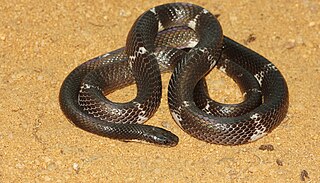
Kelaart's pipistrelle is a species of vesper bat found in southern and south-eastern Asia from Pakistan to Indonesia.
Heliogomphus ceylonicus is a species of dragonfly in the family Gomphidae. It is endemic to Sri Lanka. Its natural habitats are subtropical or tropical moist lowland forests and rivers. It is threatened by habitat loss.

Bungarus ceylonicus, the Ceylon krait or Sri Lankan krait, is a species of venomous elapid snake which is endemic to the island Sri Lanka, locally known as මුදු කරවලා.
Gerrhopilus ceylonicus, also known as the Sri Lanka worm snake, is a species of snake in the family Gerrhopilidae. It is endemic to Sri Lanka.
Clanculus ceylonicus is a species of sea snail, a marine gastropod mollusk in the family Trochidae, the top snails.
Wanniyala is a genus of cellar spiders native to Sri Lanka, first described by Huber & Benjamin in 2005. They have six eyes and four pair of legs and grow up to 2 mm in length. The abdomen is globular and males have a distinctive distal hinged sclerite on the procursus of genitalia. The name is derived from the Sri Lankans native to the island that the first spiders were found on- the Vedda people- and their surname Wanniyala-Aetto.
Derolathrus ceylonicus, is a species of Jacobson beetle endemic to Sri Lanka.
Ideoblothrus is a genus of pseudoscorpions in the Syarinidae family. It was described in 1892 by Italian naturalist Luigi Balzan as a subgenus of Ideobisium.
Ideoblothrus nesotymbus is a species of pseudoscorpion in the Syarinidae family. It is endemic to Australia. It was described in 1991 by Australian arachnologists Mark Harvey and Karen Edward. The specific epithet nesotymbus comes from Greek: nesos (‘island’) and tymbos (‘tomb’), with reference to the type locality.
Ideoblothrus pisolitus is a species of pseudoscorpion in the Syarinidae family. It is endemic to Australia. It was described in 1991 by Australian arachnologists Mark Harvey and Karen Edward. The specific epithet pisolitus refers to the pisolitic geology of the type locality.
Ideoblothrus milikapiti is a species of pseudoscorpion in the Syarinidae family. It is endemic to Australia. It was described in 1991 by Australian arachnologists Mark Harvey and Karen Edward. The specific epithet milikapiti refers to the type locality.
Ideoblothrus curazavius is a species of pseudoscorpion.
Ideoblothrus maya is a species of pseudoscorpion. It is only found within the type locality of one unnamed cave off San Roque Road in Oxkutzcab, Yucatán, Mexico.
Ideoblothrus grandis is a species of pseudoscorpion. It is only found within Cueva del Tio Ticho, Chiapas, Mexico.
Ideoblothrus seychellesensis is a species of pseudoscorpion. It is found in the Seychelles on Felicite Island and Silhouette Island. As of 2012, the species has been considered endangered and is listed on the IUCN red list.

